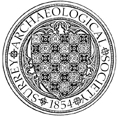Former St Andrew’s Playing Field, Cobham
Evaluation by M Saunders of TVAS for Fairview New Homes plc found much of the site had been disturbed by the construction and demolition of a military works and by the creation of the playing field. No archaeological features or finds were recovered. (301)


